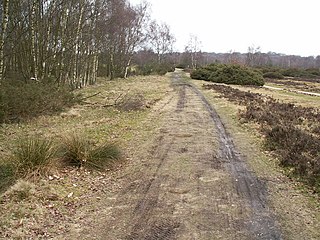
Icknield Street or Ryknild Street is a Roman road in England, with a route roughly south-west to north-east. It runs from the Fosse Way at Bourton on the Water in Gloucestershire to Templeborough in South Yorkshire. It passes through Alcester, Studley, Redditch, Metchley Fort, Birmingham, Sutton Coldfield, Lichfield, Burton upon Trent and Derby.

Wirksworth is a market town in the Derbyshire Dales district of Derbyshire, England, with a population recorded as 5,038 in the 2011 census. It contains the source of the River Ecclesbourne. The town was granted a market charter by Edward I in 1306 – it is still held today on Tuesdays in the Memorial Gardens. The parish church of St Mary's is thought to date from 653. Wirksworth developed as a centre for lead mining and later stone quarrying. Many lead mines in the area were owned by the Gell family of nearby Hopton Hall.
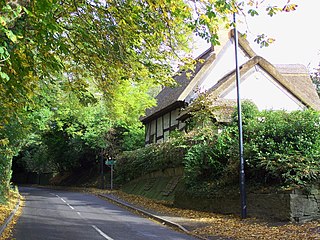
Littleover is a village and suburb in the city of Derby, in Derbyshire, England, between Rose Hill, Normanton, Sunny Hill and Mickleover, about three miles (4.8 km) southwest of Derby city centre.

Chellaston is a suburban village on the southern outskirts of Derby, a city in Derbyshire in the East Midlands of England. It is situated on a natural hill, and has developed into a residential suburb as Derby has expanded.

Duffield is a Derbyshire village in the Amber Valley district of Derbyshire, 5 miles (8.0 km) north of Derby. It is centred on the western bank of the River Derwent at the mouth of the River Ecclesbourne. It is within the Derwent Valley Mills World Heritage Area and its elevated surroundings are the southern foothills of the Pennines.
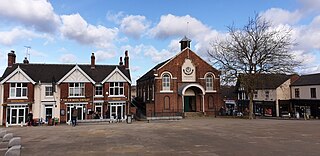
Swadlincote is a former mining town in the district of South Derbyshire, England. It borders the counties of Leicestershire and Staffordshire and is 5 miles (8 km) south-east of Burton upon Trent, 5 miles (8 km) north-west of Ashby-de-la-Zouch and 11.5 miles (19 km) south-west of Derby. It also covers Newhall, Oversetts, Midway and the villages of Church Gresley and Woodville, with the sub-district of Goseley, and has a population of 36,000. Castle Gresley is 2 miles (3 km) to the south-west and Albert Village 1.5 miles (2 km) to the south.
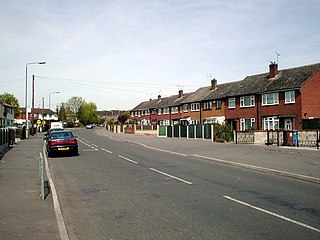
Chaddesden, also known locally as Chad, is a large residential suburb of Derby, United Kingdom. Historically a separate village centred on Chaddesden Hall and the 14th century St Mary's Church, the area was significantly expanded by 20th century housing developments, and was incorporated into Derby in 1968.
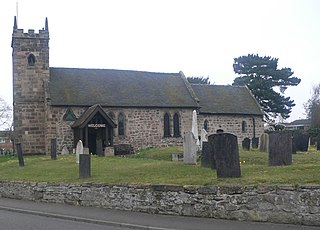
Willington is a village and civil parish in the South Derbyshire district of Derbyshire, England. The 2001 Census recorded a parish population of 2,604, increasing to 2,864 at the 2011 Census.

Milford is a village in Derbyshire, England, on the River Derwent, between Duffield and Belper on the A6 trunk road.

Ockbrook is an ancient village in Derbyshire, England. It is almost contiguous with the village of Borrowash, the two only separated by the A52. The appropriate civil parish is Ockbrook and Borrowash. The population of this civil parish at the 2011 Census was 7,335. Ockbrook lies about 5 miles (8.0 km) east of Derby.

Derventio was a small town in the Roman province of Britannia. Today the area is known as Little Chester, on the outskirts of Derby, located in the English county of Derbyshire.

Shottle is a village roughly 3 miles south of the market town of Wirksworth, Derbyshire, England. The population of the civil parish at the 2011 Census was 266.

Derby is a city and unitary authority area in Derbyshire, England. It lies on the banks of the River Derwent in the south of Derbyshire, of which it was traditionally the county town. Derby gained city status in 1977, and by the 2011 census its population was 248,700.

Hollington is a village in the Staffordshire Moorlands in English county of Staffordshire. There are several villages of this same name, and there is a Hollington, Derbyshire a few miles to the east in Derbyshire. The population taken at the 2011 census was 212.
Sir Simon Degge (1612–1703) was born in Staffordshire but settled in Derby. He became a High Sheriff of Derbyshire and served North Wales as a Justice. It was said that he served his year as Sheriff in "barrister robes and with a sword by his side". Degge was a Royalist and wrote a reference book on the law and rights of a parson called the Parson's Counsellor.... The book includes advice on the income from a glebe, Jus patronatus and the crime of Simony.

Hungry Bentley is a deserted medieval village and civil parish in the Derbyshire Dales district of Derbyshire, England, located between Uttoxeter and Derby. The site is a scheduled monument and has been called the best "depopulated settlement" in Derbyshire. The name Bentley is said to mean a clearing with bent grass. The more unusual appellation of "Hungry" is said to refer to the poor quality of the land and the local inhabitants' poor food.

Strutt's Park Roman Fort was a Roman fort in Strutt's Park, a suburb of Derby in Derbyshire, England. It was built around the year 50 and replaced, probably between the years 75 and 80, by a new fort at Little Chester on the opposite bank of the River Derwent.

The Derby Racecourse Roman settlement was the third settlement in Derby or Derventio was a small town in the Roman province of Britannia. It lies 600m east of Derventio fort in Little Chester, on the outskirts of Derby, in the English county of Derbyshire. The Roman road from Derventio to Sawley on the River Trent passes the settlement. It is a scheduled National Monument.

The Street is the medieval name of the Roman road that ran across the high limestone plateau of central Derbyshire from the spa town of Buxton southeast towards modern Derby. The line of the road can be traced from surviving features, confirmed by archaeology, from Buxton as far as Longcliffe just north of Brassington. It is believed that from Brassington the road ran eastwards to Wirksworth and there joined another road which crossed the Derwent at Milford and ran on the east bank of the Derwent and can be traced to the northern suburbs of Derby to Little Chester, the site of the Roman settlement of Derventio. The 1723 map of Brassington Moor shows The Street road from Buxton through Pikehall up to the Upper Harborough Field Gate, leading onto Manystones Lane & Brassington Lane towards Wirksworth. In records from 1613 the road from Brassington to Wirksworth is called 'Highe Streete'.

Lutudarum was a small town in the Roman province of Britannia, in the area that is now mid-Derbyshire. The settlement is believed to have been at either Wirksworth or nearby Carsington, although Matlock and Cromford are other candidates. The town was recorded as Lutudaron between Derventio and Veratino (Rocester) in the Ravenna Cosmography's list of all known places in the world in about 700 AD.